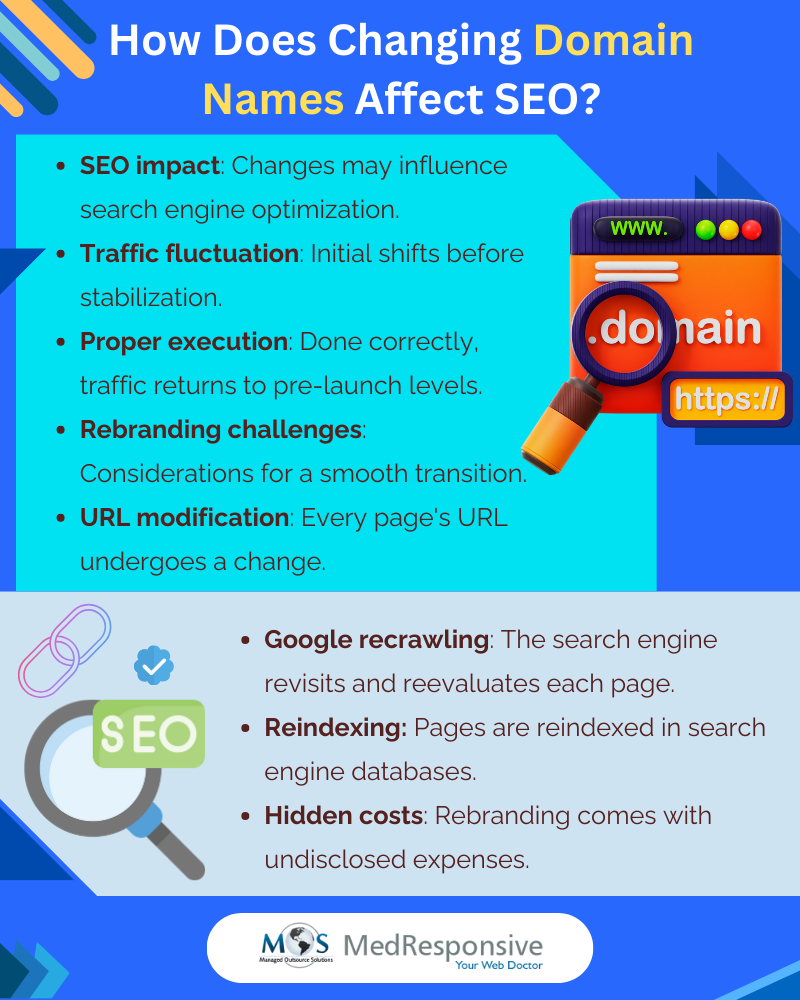At some point in your website’s marketing journey, you may have to decide to change your site’s domain name either to rebrand for expansion, adopt a more widely recognized top-level domain (TLD), or enhance your digital marketing capabilities.
Changing your existing domain name results in a modification of the URL for every page on your website, which will harm the search engine rankings, authority, and website traffic. This is because search engines use metrics on both the domain level and the page level to determine rankings. Opting for a new domain essentially resets these metrics to zero. Fortunately, there are measures one can implement to mitigate and, in some instances, entirely counteract the impact of a domain move. A professional SEO outsourcing company can play a crucial role in facilitating a smooth and effective transition when changing website domains.
As all the URLs of your website are changed, all the backlinks that had been pointing to your old domain will no longer point to your website.
Tips to Minimize the SEO Impact of Changing Domains
Confused as to whether you can change your website’s domain name without affecting SEO?
The answer is “No”. There are some hidden costs of rebranding. Changing the current domain name changes the URL of every page on your website, which results in Google recrawling, re-evaluating and re-indexing each page. However, you can follow some critical measures to let you web traffic come back to pre-launch levels.
Here are some key considerations and steps to minimize the impact on SEO.
Choose a new domain name wisely:
Make sure to choose a domain name that is easy to spell, and type. Focus on flexibility while choosing a domain name, as it ensures that it can grow with your online business and avoid the need for another name change in the future. Also, try to choose a short name, as it is easy to remember. Even though the domain name is not a direct ranking factor itself, it can still impact your site’s traffic and conversions. Also, consider migrating all the content from the old domain to the new domain.
Prioritize choosing a domain with a “.com”. But, if you can’t get a “.com” domain name, consider choosing a new second-level domain or choose “.co,” “.org”, or “.biz”. Ideally, when considering a domain name change, it’s essential to carefully assess both the potential SEO implications and the impact on your overall brand strategy.
301 redirects:
A 301 redirect is a permanent redirect that informs search engines that the content from the old URL has moved to a new location. This ensures a seamless transition for both users and search engines, preserving the accumulated SEO value of the original domain.
Implementing 301 redirects from the old domain to the corresponding pages on the new domain tells search engines that the content has permanently moved. This helps preserve the SEO value associated with the original pages.
Key steps include:
- Plan your redirects: Identify the pages on your old domain and determine their corresponding URLs on the new domain.
- Access server configuration: If you have access to your server, you can set up redirects in the server configuration files.
- CMS or web hosting platform: If you’re using a Content Management System (CMS) or a web hosting platform, there are often built-in tools to set up redirects. In platforms like WordPress, you can use plugins or the built-in Redirection tool.
- Google Search Console update: Update your sitemap in Google Search Console with the new URLs.
- Update internal links: Update internal links on your website to point to the new domain.
Effectively implementing 301 redirects for a website domain change can help maintain a smooth transition without negatively impacting your SEO.
Update internal and external links:
Updating internal and external links when changing website domains is crucial for maintaining a seamless and effective online presence. Updating internal links ensures that visitors navigating through your website won’t encounter broken links or redirects, preserving a smooth and positive user experience. This ensures a seamless user experience and helps search engines understand the structure of your new site. Search engines understand the new structure of your website, ensuring that your pages are properly crawled, indexed, and ranked.
Updating external links helps maintain the integrity of the valuable backlinks, preventing a loss of link authority. Consistent and accurate links also contribute to the credibility and trustworthiness of your website. When users or other websites encounter functioning links, it reinforces the reliability of your content. Updating links is essential for accurate tracking and analytics.
Update social media profiles:
Updating social media profiles when changing website domain names is essential for many reasons. It ensures a consistent brand identity across all online platforms, promoting recognition and trust among your audience. By updating these links, you provide accurate information to your followers, directing them to the correct website and preventing confusion. Outdated links or information can create doubt among your audience, impacting their perception of your reliability and professionalism.
Search engines consider social signals when ranking websites. Consistent and accurate information across various online platforms, including social media, can positively influence your search engine rankings. Social media profiles should reflect the latest changes, maximizing the effectiveness of your cross-promotional efforts.
Ensure that the content and metadata (titles, descriptions) on the new domain remain consistent with the previous version. Consistency helps maintain the relevance and ranking signals. Also, regularly monitor crawl errors and other issues in Google Search Console to identify and address any issues related to the domain change promptly.
It’s important to note that even with careful planning, there might be a temporary fluctuation in rankings as search engines adapt to the changes. However, if the domain migration is executed correctly, the impact on SEO should be minimal, and the site should regain its rankings over time.
An experienced provider of professional SEO services can help with diverse strategies such as – SEO strategy planning, keyword research and integration, 301 redirect implementation, Google Search Console configuration, content optimization, backlink analysis and management, and social media profile updates.



